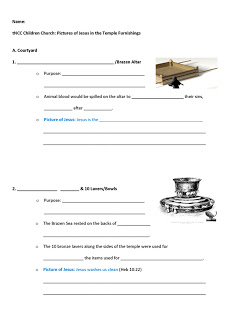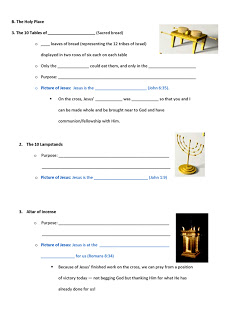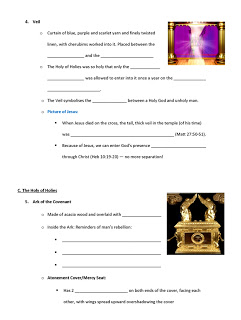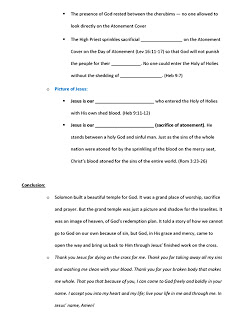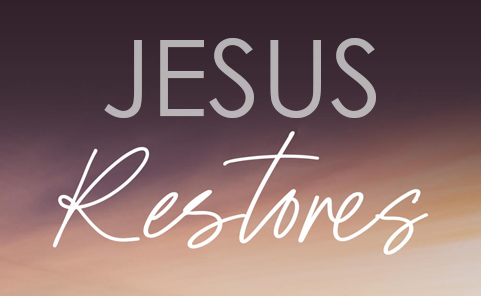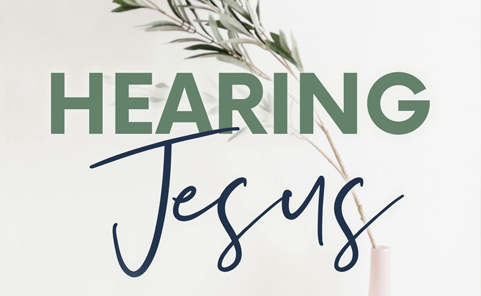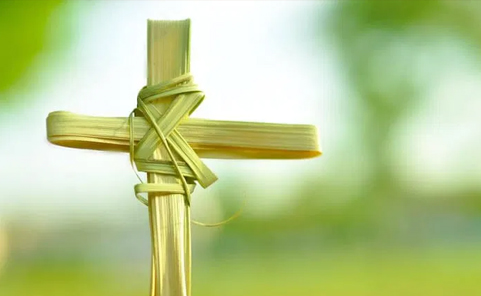The Temple’s Furnishings
1. Lesson: The Temple’s Furnishings (1 Kings 7, 2 Chron 4) Last week, we learnt about how Solomon built a temple to God...
1. Lesson: The Temple’s Furnishings (1 Kings 7, 2 Chron 4)
- Last week, we learnt about how Solomon built a temple to God. It was built:
- with the best materials and by the best craftsmen
- as God’s house where God’s people could come to pray and receive forgiveness of their sins
- We also learned that the temple was temporary … a picture of who us today — we are the temple of the Holy Spirit, and that God lives in us forever!
- The layout and furnishing of the temple is similar to the tabernacle that the Israelites used to worship God in since they came out of Egypt. (Exodus 25-27). The temple was about double the size of the tabernacle, and some of the furnishing were multiplied (10x).
- Everything about the temple — layout and furnishings — are made according to perfect specifications because it serves as “a copy and shadow of what is in heaven”. (Heb 8:5)
- Today we will looks at some of the furnishings in the temple and see how they are a picture of Jesus and His finished work on the cross.
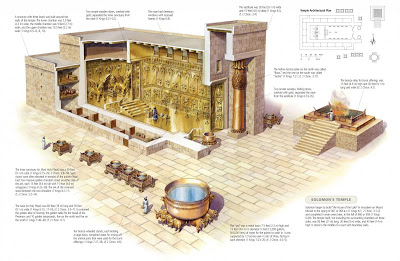
- The temple:
- Outside of the temple:
- Altar of Burnt Offering/Brazen altar
- Brazen sea
- 10 lavers
- The porch (portico/vestibule)
- The Holy Place/Greater House/temple
- 10 tables of Showbread
- 10 Golden Lampstands
- Altar of incense
- The inner sanctuary, the “Holy of Holies”
- Ark of the Covenant
- Outside of the temple:
1. Outside the temple/Courtyard
a. Altar of Burnt Offering/Brazen Altar
- Made of acacia wood and overlaid with bronze (symbol of God’s judgment against sin)
- God asked Israelites to make it as part of their worship in the desert (Exodus 27:1-8)
- This was where the Israelites would offer their burnt animal offerings to God for their sins year after year.
- Animal blood would be spilled on the altar to atone (cover up) their sins.
- Picture of Jesus:
- Jesus was the perfect offering to God who shed His blood for our sins. The animals’ blood could only cover up our sins, but Jesus’ blood takes away/removes all our sins (John 1:29).
- Just as the altar was located outside the temple, Christ died outside of the camp as a sacrifice once and for all.
b. Brazen Sea & 10 Lavers/Bowls
- Every priest had to wash his hands and feet before entering the place of worship or risk being struck dead. (Exodus 30:17-21)
- At the tabernacle, they used a small laver made of the women’s hand mirrors. But Solomon built a large Brazen Sea for the priests to wash themselves outside the temple.
- The Brazen Sea was a large bronze basin about 15 feet in diameter and over 7.5 feet high (higher than our mommies and daddies). It rested on the backs of 12 bronze oxen.
- There were 10 bronze lavers/bowls along the sides of the temple. These were wash basins to rinse the items used for burnt sacrifices.
- Picture of Jesus:
- The priests could not approach God’s presence without washing themselves. Today, Jesus’ He washes us clean. So we can enter God’s presence boldly and with confidence.
- “Let us draw near to God with a sincere heart in full assurance of faith, having our hearts sprinkled [with blood] to cleanse us from a guilty conscience and having our bodies washed with pure water.” (Hebrews 10:22)
2. The Holy Place
c. The 10 Tables of Showbread (Sacred bread)
- Small tables made of acacia wood and overlaid with pure gold.
- The Table of Showbread (or Bread of the Presence) was set at all times just as a king’s table is always set and prepared for his arrival.
- The Lord commanded that on this table there were to be 12 loaves of bread (representing the 12 tribes of Israel) displayed in two rows of six each (In Solomon’s temple, total number of loaves = 12 x 10 = 120).
- They were to be made with the finest flour; they were to be flat (or unleavened) and eaten by the priests only, and only in the Holy Place. The priest would put the bread on the table for a week, then eat it on the Sabbath in the Holy Place and replace it with fresh bread. (Lev 24:5-8)
- The bread was a reminder of God’s provision of manna for the 12 tribes of Israel throughout their 40-year journey in the desert.
- The Showbread is also called the “Bread of the Presence” because it was always in the Lord’s presence. The table and the bread are a picture of God’s desire to fellowship and commune with man — an invitation to share a meal together. (Rev 3:20)
- Picture of Jesus:
- Jesus says He is the bread of life (John 6:35). The manna and physical bread can only sustain our physical life; but the Bread of Life gives us eternal life in Christ.
- Before He died, Jesus took bread, broke it and gave it to His disciples saying “Take and eat; this is my body.” (Matt 26:26)
- On the cross, Jesus’ body was broken so that you and I can be made whole and be brought near to God and have communion/fellowship with Him.
- Every time we take the Holy Communion, we are reminded of Jesus’ broken body on the cross.
d. The 10 Lampstands
- Had to be always lit/kept burning by the priests (Exodus 27:20-21)
- Provided light in tabernacle/temple — a reminder to the Israelites that God provided light (pillar of fire) when they travelled through the desert for 40 years (Exodus 13:20-21)
- Picture of Jesus:
- Jesus is the light of the world — the true light that gives light to every man (John 1:9)
- Jesus promised that when we follow Him, we will “never walk in darkness but will have the light of life”. (John 8:12) We also reflect Jesus’ light to the world.
e. Altar of Incense
- Every morning and evening, the priest was to burn incense upon this altar, filling the air with the sweet aroma of the incense. Symbolising the prayers/intercession of God’s people rising up to God’s throne.
- Picture of Jesus:
- Jesus is at the right hand of the Father interceding for us (Romans 8:34)
- Because of Jesus’ finished work on the cross, we can pray from a position of victory today — not begging God but thanking Him for what He has already done for us!
f. Veil
- Curtain of blue, purple and scarlet yarn and finely twisted linen, with cherubims worked into it. Placed between the Holy Place and the Most Holy Place/Holy of Holies.
- The Holy of Holies was so holy that only the High Priest was allowed to enter into it. Once a year on the tenth day of the seventh month, the Day of Atonement, the High Priest was permitted to pass through the veil and enter into the presence of God. This was the time when the High Priest sought the Mercy of God and made atonement for his sins and the sins of the people of Israel.
- The Veil symbolises the separation between a Holy God and unholy man. Man could not simply enter God’s presence or they could fall down dead.
- Picture of Jesus:
- When Jesus died on the cross, the tall, thick veil in the temple (of his time) was miraculously torn in two, from top to bottom (Matt 27:50-51).
- The torn veil illustrated Jesus’ body broken for us, opening the way for us to come to God. As Jesus cried out “It is finished!” on the cross, He was indeed proclaiming that God’s redemptive plan was now complete. The age of animal offerings was over. The ultimate offering had been sacrificed.
- Because of Jesus, we can enter God’s presence boldly and confidently through Christ (Heb 10:19-20) — no more separation!
3. The Holy of Holies
g. Ark of the Covenant
- Made of acacia wood and overlaid with pure gold, inside and out. To be carried by poles at the sides of the ark only by the Levites — too holy to be touched
- Inside the Ark: Tablets of 10 Commandments — Reminders of man’s rebellion (golden calf)
- Covering on top of the ark
- Has 2 cherubims on both ends of the cover, facing each other, with wings spread upward overshadowing the cover
- The presence of God rested between the cherubims — no one allowed to look directly on the Atonement Cover
- The High Priest sprinkles sacrificial blood on the Atonement Cover on the Day of Atonement (Lev 16:11-17) so that God will not punish the people for their sins. No one could enter the Holy of Holies without the shedding of blood. (Heb 9:7)
- Beautiful picture of God’s mercy and forgiveness over man’s rebellion and sin.
- Picture of Jesus:
- Jesus is our High Priest who entered the Holy of Holies with His own shed blood. (Heb 9:11-12)
- Jesus is our mercy seat. He stands between a holy God and sinful man. Just as the sins of the whole nation were atoned for by the sprinkling of the blood on the mercy seat, Christ’s blood atoned for the sins of the entire world.
- Romans 3:23-26 for all have sinned and fall short of the glory of God, 24 and all are justified freely by his grace through the redemption that came by Christ Jesus. 25 God presented Christ as a sacrifice of atonement (mercy seat), through the shedding of his blood—to be received by faith. He did this to demonstrate his righteousness, because in his forbearance he had left the sins committed beforehand unpunished— 26 he did it to demonstrate his righteousness at the present time, so as to be just and the one who justifies those who have faith in Jesus.
- Conclusion:
- Solomon built a beautiful temple for God. It was a grand place of worship, sacrifice and prayer.
- But the grand temple was just a picture and shadow for the Israelites. It was an image of heaven, of God’s redemption plan. It told a story of how we cannot go to God on our own because of sin, but God, in His grace and mercy, came to open the way and bring us back to Him through Jesus’ finished work on the cross.
- If you would like to accept Jesus’ finished work on the cross and His life in you, pray along with me:
- Thank you Jesus for dying on the cross for me. Thank you for taking away all my sins and washing me clean with your blood. Thank you for your broken body that makes me whole. That you that because of you, I can come to God freely and boldly in your name. I accept you into my heart and my life; live your life in me and through me. In Jesus’ name, Amen!
2. Worksheets
